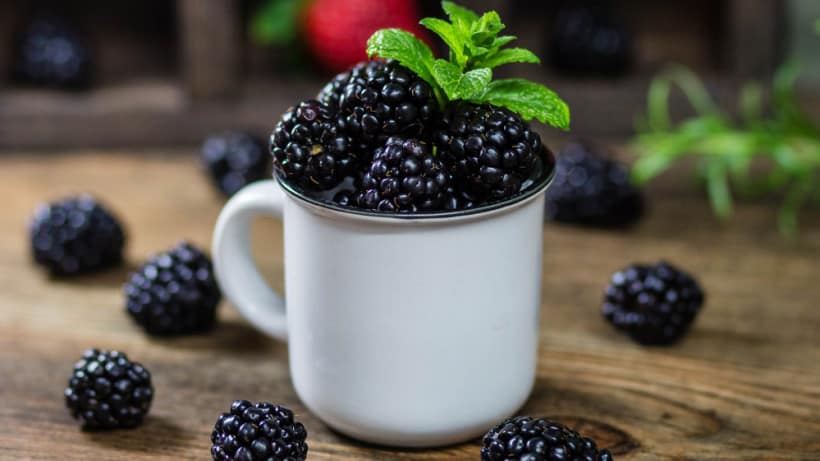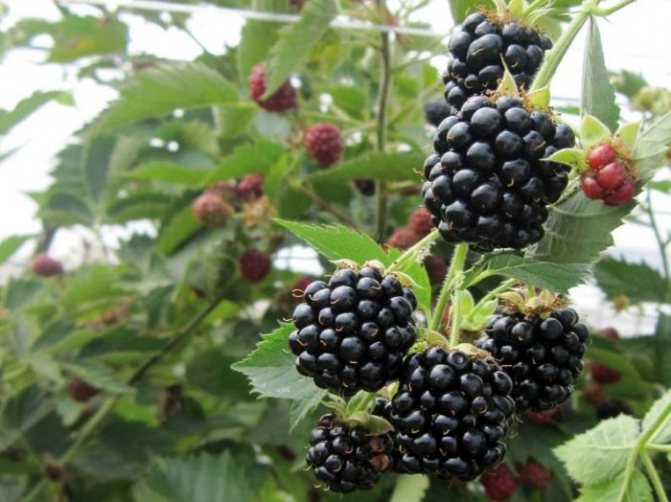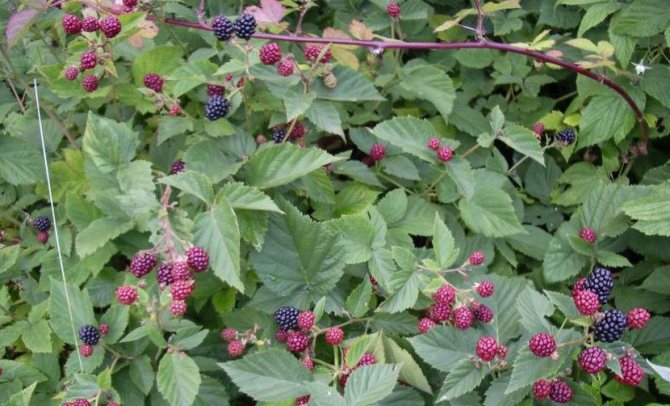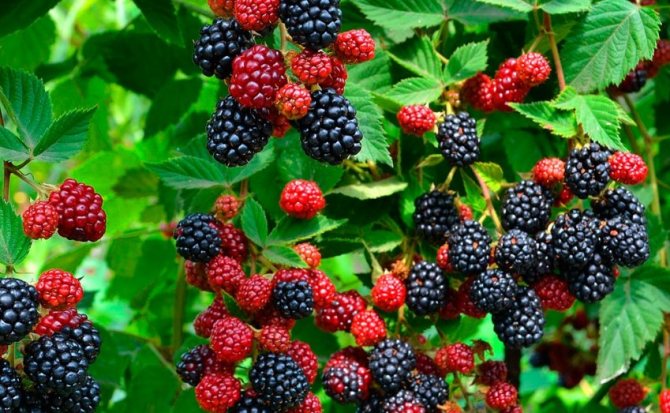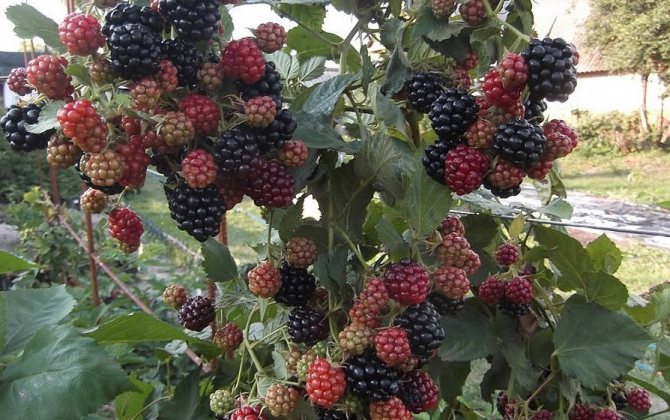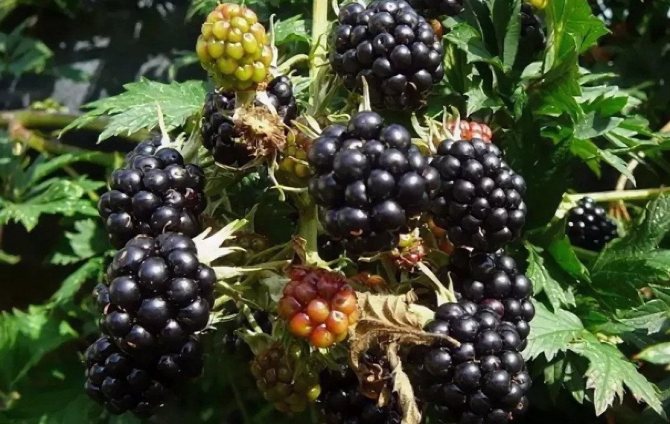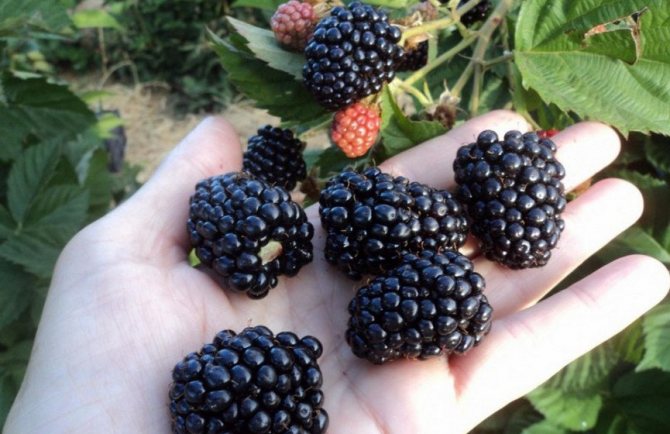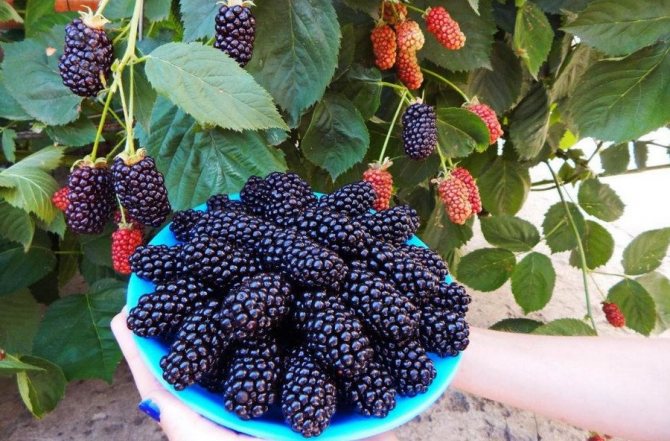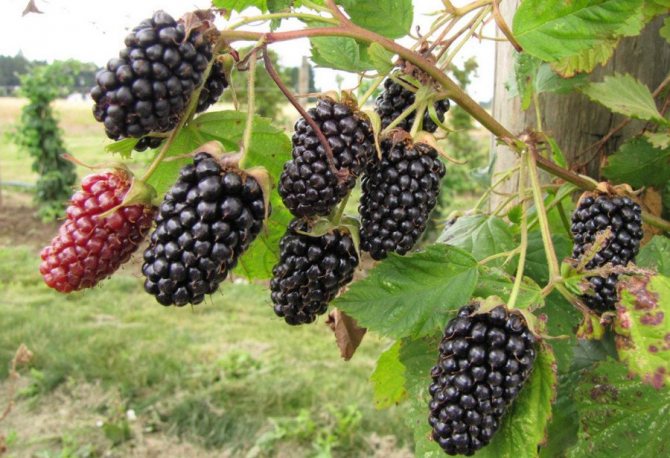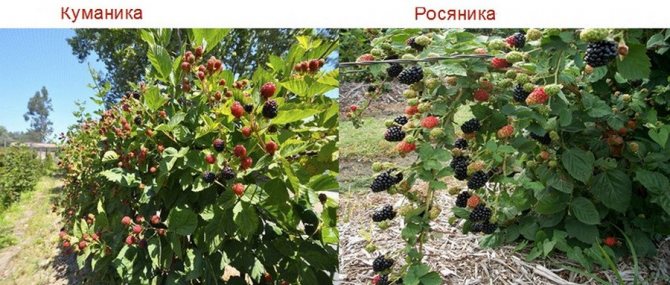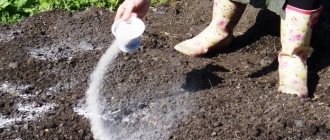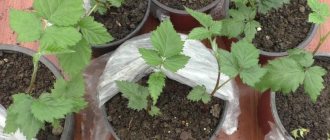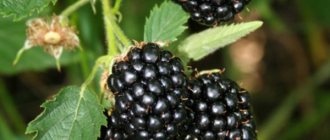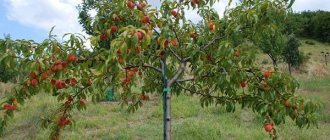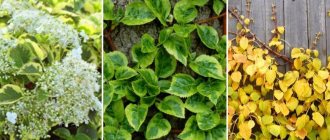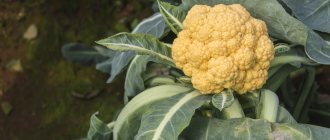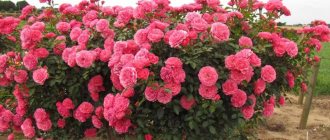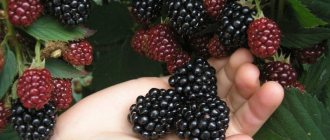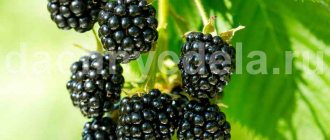The repairing blackberry became known to gardeners of the Moscow Region relatively recently, but even in a short time, the plants of this variety managed to win the ardent love of gardeners. The secret is that such bushes do not require special care, moreover, they do not need shelter for the winter. Another plus of such blackberries, which raspberries cannot boast of is the possibility of almost complete pruning without prejudice to the future harvest.
- 1 About the berry
- 2 Description and characteristics of the variety
- 3 Advantages and disadvantages
- 4 Subtleties of planting and care
- 5 Collection
- 6 Video "Blackberry Ruben"
What is different from regular blackberries
It differs from a simple blackberry remontant in the possibility of repeated fruiting. The first berries ripen on the shoots of the previous year, and the second - on the shoots of the current one, which have grown over the summer. If you take care of the plant, as for an ordinary blackberry, then it will bear fruit once. But remontant involves carrying out competent pruning for the winter. Shoots (old and young) are shortened to stumps 20-25 cm from the soil surface.
Then they carry out top dressing and shelter, for which peat, sawdust or covering material are used. Overwintered bushes will give the first harvest in June-July. And the regrown twigs will delight you with repeated fruiting in August-September.
general description
The cultivation of remontant blackberry varieties is becoming more and more popular. They are distinguished by their ability to produce a crop twice during the growing season, if weather conditions permit. The shrub is unpretentious and does not require special care. The first fruiting usually occurs in early summer, and the second time the berries begin to ripen in September.
Using a one-year cycle, pruning old stems for the winter, berries begin to appear only on young branches, starting in August.
The care and flowering period, as well as the ripening of berries, are similar for all remontant blackberry varieties. The differences relate to varietal forms and organoleptic characteristics of the fruit.
There are types of repairing blackberries with and without thorns.
Plants with thorns are quite compact, with shoots growing upward. During flowering, the bush is abundantly covered with a cap of fragrant flowers, becoming like a lush bouquet. The bush blooms for a very long time, even when some berries are already ripe, flowering still continues.
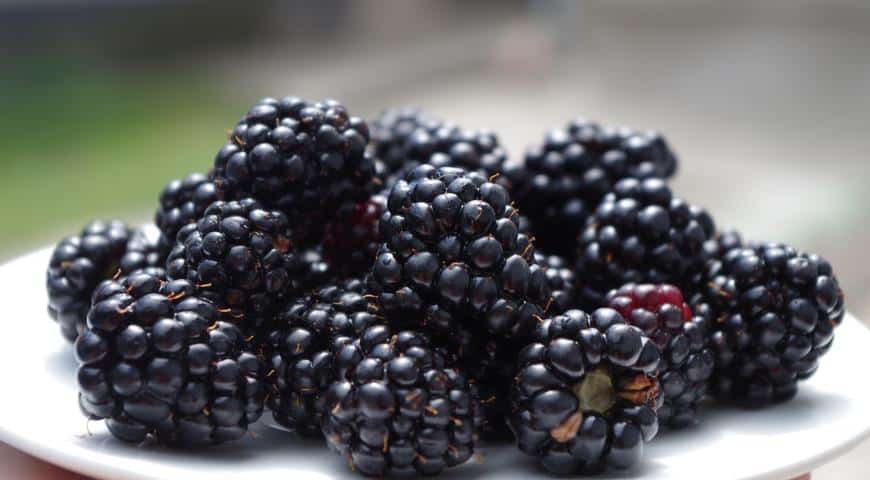
The fruits are quite large and juicy, with an excellent aroma.
Using a one-year development cycle, with the onset of cold weather, all ground branches are cut off, covering only the roots of the bush from freezing. There are many advantages to using the plant in this way.
There is no need to fight rodents in winter, the plant is not afraid of spring frosts. In addition, there is no need for annual treatments with chemicals, the fruits will be environmentally friendly.
Repaired varieties are distinguished by their ability to bear fruit in the first year after planting. And if you do not carry out a full autumn pruning, then such bushes bear fruit twice a season. Bushes of remontant varieties also have some external differences: the bushes grow more compactly, having a long and abundant flowering.
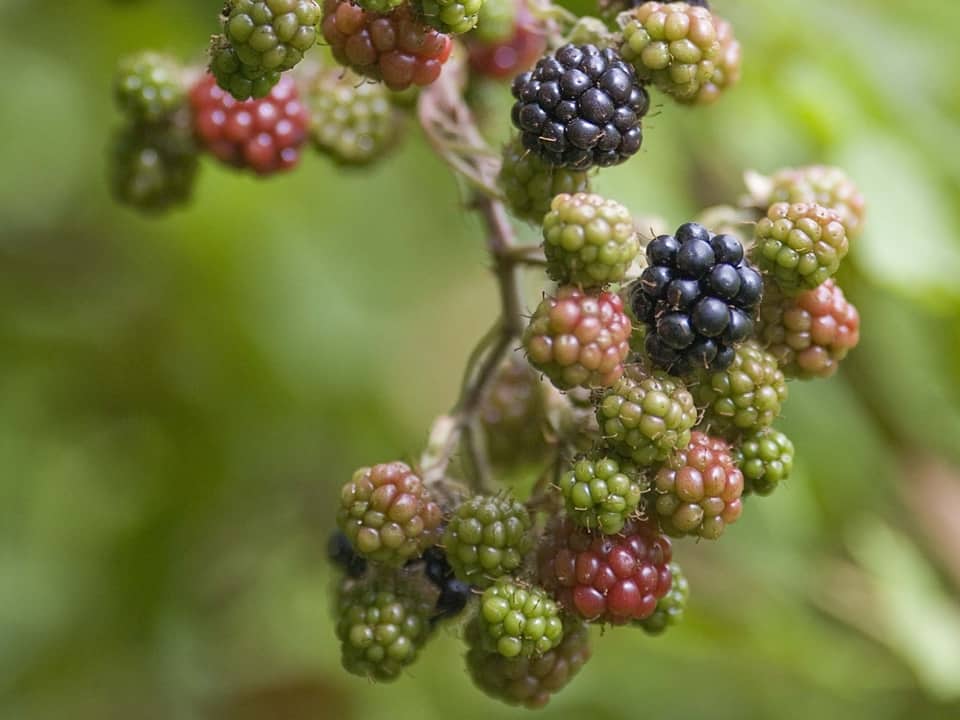

Pros and cons of remontant varieties
Gardeners who have such a plant in the country note the positive qualities of the shrub:
- The plant is easy to prepare for winter. Pruning and shelter exclude freezing of the ground part of the plant.
- Artificially induced late flowering protects the blackberry from recurrent frosts: the ovaries are not damaged, the harvest is guaranteed.
- For spring planting (April - early May), the berries will ripen in August-September. Ordinary blackberries will delight the harvest only next spring.
- Low winter pruning is pest prevention. The affected branches are cut to a healthy area and burned.
- The bushes are very decorative throughout the season: they are either covered with fragrant flowers or ripening fruits.
- The plant is compact. When planting, it is not required to restrict the bed, it will not creep over the site.
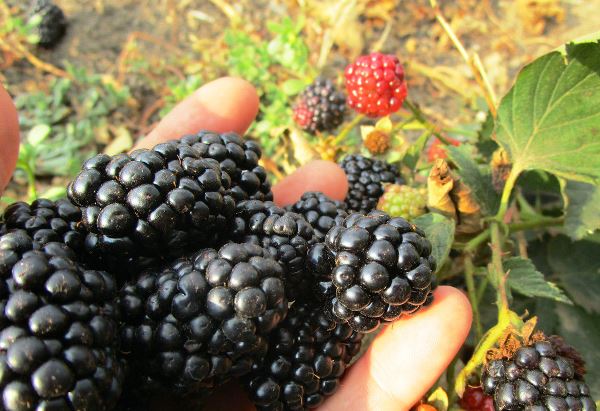

But there are also disadvantages:
- the total weight of two crops is not more than the weight of one crop of ordinary blackberries;
- increased need for hydration of the ridge;
- congested bushes require solid support.
Repeated fruiting enables the grower to gradually process the bountiful harvest.
Advantages and disadvantages
Such varieties are becoming more and more popular among residents of Russia, and in particular the Moscow region, as they have a number of advantages, and also because they do not require additional care. They have the following properties (by the way, remontant raspberries differ in the same properties):
- Decorativeness of the bushes. These plants are the undisputed decoration of your garden, giving large fragrant flowers that abundantly cover the bush. At the same time, the flowering period sometimes lasts until frost, along with fruiting.
- Fruiting twice a day. Repaired blackberries, like raspberries, are prone to fruiting twice in one season.
- Compactness. Plants of these varieties form a compact shrub, without forcing the gardener to resort to installing trellises.
- Easy trimming. The berry of these varieties can be effectively grown in a one-year cycle. This means that the bushes do not need winter care. They can simply be cut short (in particular, those shoots that have already borne fruit), covering only the root for the winter, without prejudice to the future harvest.


The only drawback that nature has awarded such a plant is its increased thorniness. But here, too, breeders came to the rescue of gardeners and presented us with the Prime Arc Freedom variety - absolutely devoid of thorns. The blackberry of this variety, in addition to the absence of thorns and subtleties, which are associated with the care and reproduction of plants, is also distinguished by the fact that it is an ideal culture for the Moscow region. Like raspberries, it grows well in our conditions, and its planting does not cause any particular difficulties.
Classification of varieties
Blackberries can be roughly divided into:
- kumaniku (its stems practically do not bend);
- dewdrop (has thin creeping stems up to 5 m long);
- semi-creeping varieties.
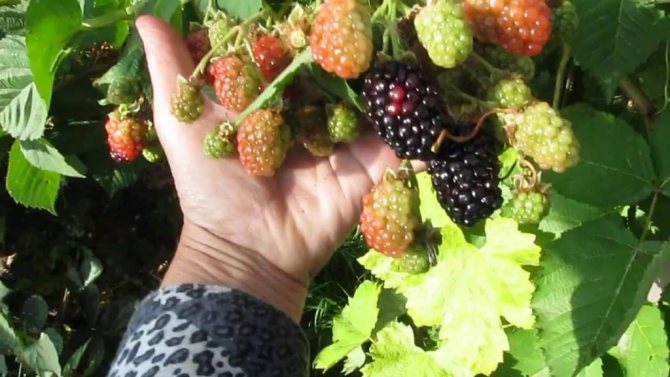

Most of the cultivated varieties grown in the gardens belong to kumanik.
By maturity
Blackberry varieties ripen at different times. According to the ripening period, plants are conventionally divided into:
- early;
- medium early;
- medium;
- medium late;
- late.
The taste of berries differs from varieties of different ripening periods.
Early
Berries on such bushes ripen at the very beginning of summer: June. But one should not expect sugariness and aroma from them: they are not. But the pulp is watery, juicy. The value of the crop is its early appearance.
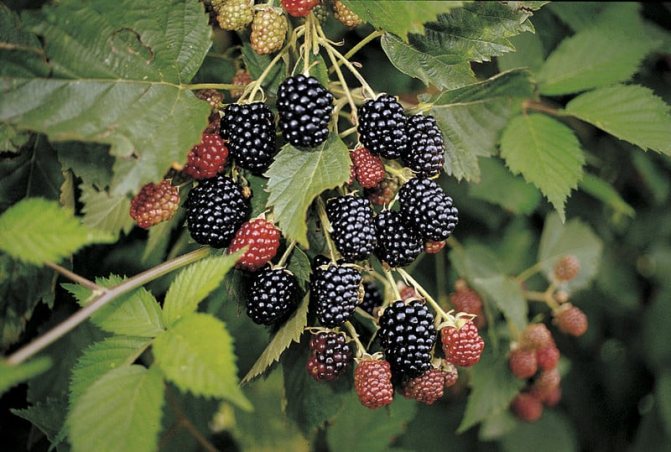

Mid-season
The berries ripen in mid-July. They are less watery, more aromatic. They are pleasant to eat fresh or to prepare compotes.
Late
Late varieties delight the gardener in August - early September. Their pulp is juicy and aromatic, the juice contains a lot of sugars. Such berries are eaten fresh, put into blanks, dried.
Winter hardy
Gardeners are attracted by winter-hardy varieties of remontant blackberries. Such bushes hibernate without shelter, their fruit buds and shoots do not freeze too much. Winter-hardy blackberry saves the gardener time to prepare bushes for winter.
See also
Description and characteristics of Brzezina blackberries, planting and careRead


By growth characteristics
The repairing blackberry has bushes of different growth patterns. It depends on the type of shoots.
New thornless blackberry varieties
Currently, surprisingly productive varieties of kumanik and dewdrop have appeared on the market. From one bush, you can collect 2 - 3 buckets of healthy and tasty berries. The mass of these berries is so great that buyers in the market refuse to take them, thinking that they are stuffed with all kinds of chemicals. After reading the description of these varieties, you will understand that this is not an exaggeration.
Natchez
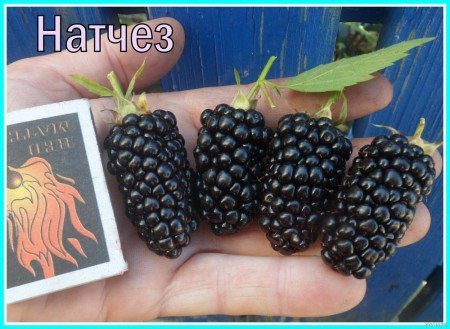

Natchez
Natchez - early ripe, very large-fruited, thornless blackberry variety.
- Productivity up to 20 kg from each bush
- The berries are very large, weighing 10 - 12 grams. sweet taste, begin to sing in June. Fruiting lasts 35 - 40 days
- Semi-erect bushes, shoots up to three meters long.
- For the winter, a cover with agrofibre is required, which is removed only after the soil thaws and the buds swell. If the bush is opened earlier, then the shoots may dry out and the plant will die. This rule also applies to other varieties of blackberries.
- When planting, you must maintain a distance between bushes 3 and between rows 2 meters
Advantages: high yield, large-fruited, early ripening, good keeping quality and transportability of berries, extended fruiting period
Disadvantages: low winter hardiness, a small number of replacement shoots.
Reviews: The reviews are very good, with a little controversy about Natchez's taste. The fruits of this blackberry variety have a sweet taste, but there is a slight bitterness in it, some do not like it, others believe that it is the bitterness that gives such a unique and refined taste to these berries, and many did not feel bitterness at all.
Ouachita


Ouachita
Ouachita - thornless, large-fruited blackberries of early ripening
- The declared yield of this variety reaches 30 kg. from every bush
- Berries are large 6 - 7 gr. and with a very original taste, they begin to ripen in June. Fruiting is extended and lasts almost two months.
- Bushes are powerful erect, shoots grow up to 2.5 - 3 meters. Grown on a trellis, usually with three rows of wire.
- For the winter, the plant must be covered.
- When planting in a bush method, the distance between blackberry seedlings is 1.5 - 2 meters.
Advantages: a very extended ripening period, amazing productivity, disease resistance, berries with an original taste do not lose their marketable qualities for a long time.
Disadvantages: weak frost resistance -17º, the need to bend down rather thick shoots.
The proposed video is in English, but it clearly shows what kind of crop can be harvested from this plant. By the way, Ouachita, Auchita, Ouachita and Ouachita are the names of the same total variety, the description of which you just read.
Testimonials positive - the variety is easy to grow, not capricious. Farmers love the combination of high yields and moderately large berries with great flavor.
Chester
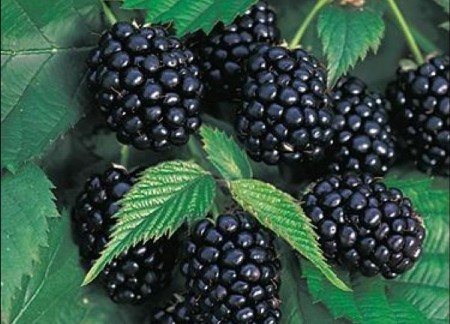

Chester
Chester is an old, well-known, thornless, large-fruited late-ripening blackberry.
- The declared yield is 15 - 20 kg. from every bush
- The berries are sweet with a slight sourness, weighing from 5 to 8 grams, ripen in late July or early August.
- The plant has a semi-sheathing bush shape. No more than 5 - 6 shoots are left for fruiting, which grow 2 - 3 meters long.
- Despite the frost resistance down to -26 ° C, shelter is required for the winter period.
- When planting, it is necessary to maintain a distance between the bushes of 2 - 2.5 meters.
Advantages: high frost resistance, absence of thorny thorns, excellent yield, good transportability of berries, the variety is resistant to major diseases and pests.
Disadvantages: despite good frost resistance, winter shelter is required. Poorly tolerates shading and planting in damp lowlands.
Testimonials: only positive, many consider Chester to be the best variety in their collection and allocate the best places for it.
Black Satin


Black Satin
Black Satin - as well as Chester, a rather old variety of thornless garden blackberries, medium ripening.
- The average yield is 10 - 15 kg, and with high agricultural technology up to 20 - 25 kg.
- Berries weighing about 5 grams, collected in large clusters. Taste from sweet - sour to sweet, ripen in mid - late July.
- Bushes are semi-creeping. Stems are tough, up to 5 meters long. It is recommended that young shoots be immediately pressed to the ground and grown in an inclined position, then it will be easier to cover for the winter.
- Frost resistance - 22 ° C and winter shelter is required in most regions.
- For cultivation, you will need a trellis with a height of about two meters.
Advantages of the variety: absence of thorny thorns, high productivity, unpretentiousness, resistance to diseases.
Disadvantages: the need to cover for the winter every year, tough shoots that often break when bending to the ground, poor transportability of berries.
Reviews: generally positive, generous, unpretentious variety, winters well under cover. But the berries are overripe quickly, you can not be late with the collection. For commercial purposes, not the best option.
Loch Tei
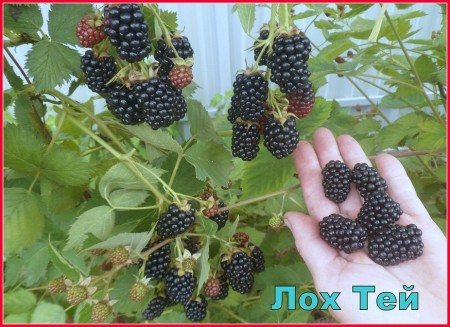

Loch Tei
Loch Tei - large-fruited, non-prickly blackberry of medium ripening.
- The declared yield is 10 - 12 kg. from every bush. Most gardeners claim that this is the case.
- The berries are large, weighing about 5 grams. The taste is sweet with sourness, ripening in mid-July.
- Loch Tei has a semi-sheathing bush shape. Shoots are vigorous, resilient, up to 5 meters long, requiring trellis.
- The frost resistance of this variety of blackberries is 20 ° C. It is not enough for our country, we have to cover it for the winter.
- When planting, the distance between the bushes is at least 2 m.
- Propagated by dropping the tops of the replacement shoots.
Advantages: good yield, lack of thorny thorns, excellent berry taste and excellent transportability.
Disadvantages: the need to cover the plant for wintering every year.
Reviews: According to most gardeners, Loch Tei is one of the best varieties of garden blackberries.
Kiova


Kiova
Kiova - blackberries with the largest berries. Unfortunately this variety has sharp thorns, but it is included in the description due to its exceptional large size.
- The yield of Kiova exceeds 30 kg. berries from one bush.
- Huge berries weigh 20 - 25 grams. They start singing at the end of July.
- The bush is erect, the height of the shoots is 1.6 - 2 meters, they require support.
- This blackberry tolerates frosts up to -23 degrees without loss. Without shelter, it can winter only in the southern regions.
Advantages: very productive variety, surprisingly large and tasty berries, good transportability, the ability to surprise neighbors.
Disadvantages: the presence of sharp thorns, the need to cover the bushes annually for the winter.
All reviews something like this: when I cover the bushes for the winter, I swear that I am suffering with these thorns for the last time, and when I start harvesting, I understand that this blackberry will always grow with me.
Columbia Star
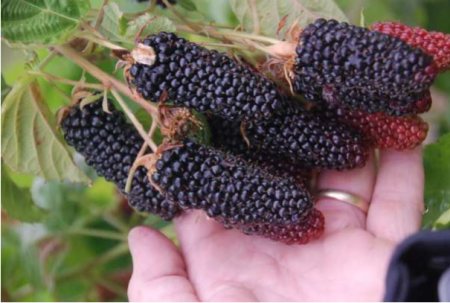

Columbia Star
Columbia Star - a new, little-known, thornless variety of early ripening blackberries.
- According to the manufacturer, Columbia Star will be one of the most productive varieties (16750 kg / ha)
- Berries of the same size, elongated, weighing 10 - 15 grams, begin to ripen in late June - early July.
- Creeping type bushes, shoots 4 - 5 meters long, without thorns.
- Columbia's winter hardiness is low - 14 degrees, winter shelter is required.
Advantages: tasty, large berries retain their presentation for a long time, high yield, rather soft and thornless shoots are easy to press to the ground for winter shelter. The variety easily tolerates heat and drought.
Disadvantages: long shoots with many lateral shoots can be difficult to untangle when removed from a support.
Reviews: gardeners who managed to plant Columbia have not yet been able to fully appreciate this variety, but everyone notes the high taste of the berries. Many consider it to be the most promising new product.
Chachanska Bestrna
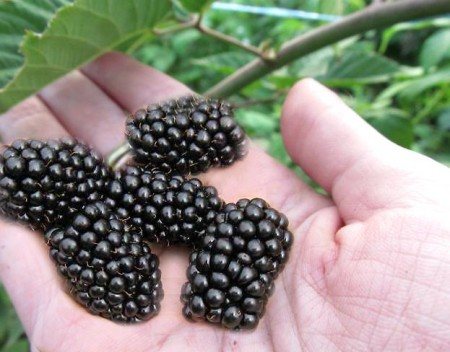

Chachanska Bestrna
Chachanska Bestrna - a high-yielding, thornless variety of early ripening blackberries.
- Productivity 12 - 15 kg. berries from one bush.
- Sweet and sour berries weighing 9-14 grams, begin to ripen in early July.
- Semi-creeping bushes, powerful shoots without thorns, grow up to 3 - 3.5 meters. A garter to the supports is required.
- The frost resistance of the variety is relatively high -26º, but it still has to be covered.
Unfortunately, the video is not of high quality, but this is all that we could find:
Advantages: high productivity, drought resistance, unpretentiousness, immunity to major diseases.
Disadvantages: poor transportability, ripe berries every other day - another begins to flow. True, for amateur gardening, this disadvantage is not very important.
Reviews: all the reviews are good, this variety has proven itself well in the southern and northern regions.
Doyle
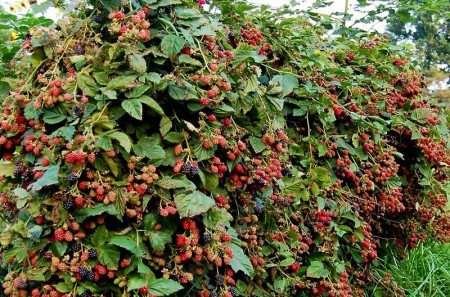

Doyle
Doyle - one of the best varieties of thornless blackberries. It claims to be the most productive variety.
- Doyle's documented yield is 5-7 buckets of berries per bush.
- Berries are sweet and sour, weighing 7 - 9 grams. Ripens later - mid-August.
- Semi-erect bushes with long, up to 5 - 6 m shoots, no thorns. Trellis required for growing
- It is necessary to cover for the winter.
Advantages: amazing productivity, easily tolerates heat and drought.
Disadvantages: this blackberry is more suitable for the southern regions, in the northern regions it may not have time to ripen.
Reviews: there are very few reviews, in Russia this variety has been cultivated for only a few years.
Waldo
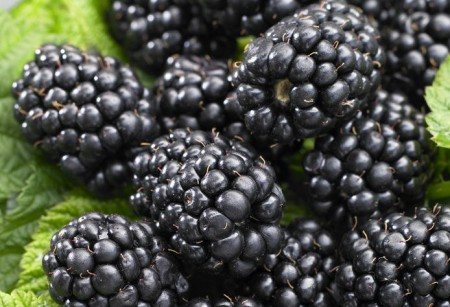

Valdo
Waldo Is an old and proven, thornless, creeping blackberry variety of medium early ripening.
- The authors of the variety promise a yield of 15 - 17 kg. berries from one bush.
- Berries weighing 6 - 8 grams. have a pleasant taste and aroma, they begin to sing in the first decade of July.
- Creeping bushes, compact. The length of the shoots does not exceed 2 meters, but support is needed.
- Average winter hardiness, winter shelter for this blackberry is required.
Advantages: no thorns, easy to cover for the winter, ideal for small areas.
Disadvantages: in hot weather, berries can be baked.
Loch Ness ‘Loch Ness’


Loch Ness
Loch Ness - thornless, very productive blackberry, medium late ripening.
- The yield of this variety can reach 25 kg. from every bush.
- The berries are sweet, with sourness, similar to the taste of wild blackberries 5 - 8 gr. They begin to ripen at the end of July.
- Loch Ness bushes are vigorous, semi-sheathing. Stems up to 4 meters long, need support.
- Winter hardiness for our climate is not high enough, the bushes have to be covered in winter.
- When planting, the distance between the bushes is at least 2 meters.
Advantages: consistently high productivity, unpretentious in care, quickly and easily multiplies, suitable for commercial use.
Disadvantages: ripens late, in a rainy summer the taste becomes sour.
Reviews: unequivocally good - with minimal maintenance, always an excellent harvest.
Oregon Thornless


Oregon Thornless
Oregon Thornless - thornless, creeping blackberry of late ripening.
- Average yield, about 10 kg. berries from each bush.
- Berries are sweet and sour, large, weighing 7 - 9 grams, ripen in August.
- The plant forms creeping bushes with thornless shoots up to 4 meters long. Trellis required for cultivation.
- Oregon can withstand temperatures down to -29 degrees, which is clearly not enough for the middle zone and cannot be done without shelter.
Advantages of the variety: excellent taste, the absence of thorny thorns, easy to cover for the winter, the decorativeness of the plant allows you to use it for decorating gazebos, arches and other buildings.
Reviews: "I have this variety in my favorites - the most problem-free - it winters well (under cover), replacement shoots appear immediately, almost simultaneously with the start of fruit shoots growth, the size of the berry with sufficient watering is really large, sweet taste, very fruitful."
Osage
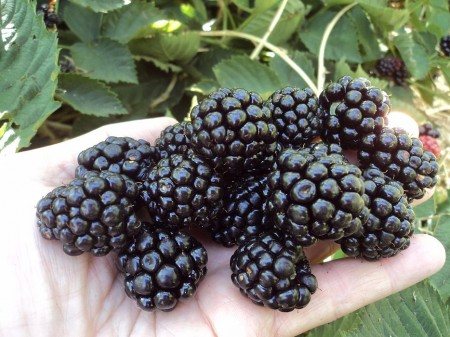

Osage
Osage - thornless blackberry with ideal taste. This variety is considered the most delicious of all blackberry varieties.
- The yield is relatively low, 3 kg. berries from each bush.
- Berries with a perfectly balanced taste and a weight of 6 - 7 grams. begin to sing in the first decade of July.
- Bushes are erect, shoots without thorns, about 2 meters high.
- Low frost resistance, only -13º, shelter is required.
Advantages: exquisite, dessert taste, the sweetest of all varieties of blackberries, never sets the teeth on edge.
Disadvantages: low winter hardiness and relatively low productivity.
Description of remontant blackberry varieties
Repaired blackberry varieties can be grown for one crop or two. In the first case, all the shoots are cut to the root in the fall and a completely empty bed is in the winter. In the spring, young shoots begin to grow from the roots at the end of August, berries begin to sing on them.
To get two full-fledged harvests next year, only last year's shoots are cut in the fall, and the young are bent to the ground, covered and allowed into the winter. In June next year, berries begin to sing on these shoots. At the end of July, having collected the entire crop, these shoots are cut out. And already at the end of August, young shoots that have grown over the summer begin to bear fruit. Thus, you feast on blackberries for almost the entire summer season.
Unfortunately, all this pleasure is available only to residents of the southern regions. In the northern regions, remontant blackberry varieties do not justify themselves. It is not uncommon for some of the berries to die from frost. The first crop (partially or completely) may die during the flowering stage from recurrent frosts. The second will begin to sing only at the end of August, or even at the beginning of September. The berries simply do not have time to ripen and part of the harvest goes under the snow.
Freedom
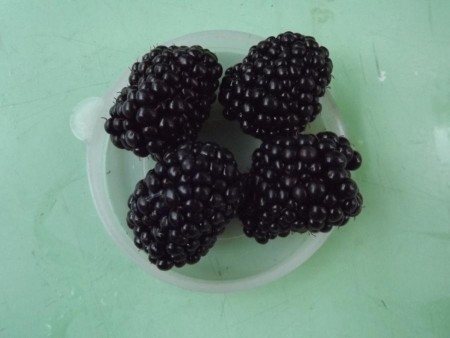

Freedom
Prime-Ark Freedom Is a studless, remontant blackberry variety.
- The authors of the variety promise high yields. The variety is new and there are no exact numbers yet.
- The berries are sweet, large, weighing 15 - 20 grams, the first harvest begins to sing from mid-June, and the second in the third decade of August.
- Bushes are erect, medium-sized, stems without thorns about 2 meters high.
- Shelter is required for the winter.
- Propagated by root shoots and cuttings.
Advantages: high productivity, excellent quality of fruits and excellent taste, the ability to receive products throughout the summer.
Disadvantages: low winter hardiness, the variety is recommended only for the southern regions, the need to bend down and cover the shoots for the winter.
Black Magic (Black Magic)


Black Magic
Black Magic (Black Magic) - remontant blackberry variety (stems with thorns)
- Productivity from 5 kg. from one bush.
- The berries are sweet, weigh an average of 7 - 10 grams. Ripening terms - the end of June, the first harvest and the last decade of August, the second harvest.
- Shoots are strong, about 1.5 meters high, there are relatively few thorns.
- Weak winter hardiness -12º, winter shelter is required.
Advantages: this variety is best adapted to the climatic conditions of our country. Excellent fruit quality, High productivity, tolerates heat and drought well.
Disadvantages: thorny shoots, low frost resistance, strong shoots are difficult to press to the ground.
Reuben


Ruben
Reuben - remontant, large-fruited variety of garden blackberry (with thorns)
- Productivity from 6 kg. from one bush.
- The fruits are sweet, large, with an average weight of about 10 grams. Ripen in late June and late August.
- Shoots are erect, medium-sized with thorns.
- The plant can withstand a drop in temperature down to -16º, a shelter is required.
Advantages: variety resistant to frost, tolerates shading well, excellent transportability of berries.
disadvantages: the main disadvantage is the sterilization of pollen already at + 30º
Prime-Ark 45


Prime Arc 45
Prime-Ark 45 - a new remontant blackberry variety (with thorns).
- Producers promise good yields, but no specific data is available yet.
- Berries are transportable, sweet taste and weighing 6 - 8 grams.
- Bushes are erect, with a moderate number of thorns. They tolerate heat and drought well.
- It does not hibernate without shelter.
Traveller - Prime-Ark Traveler
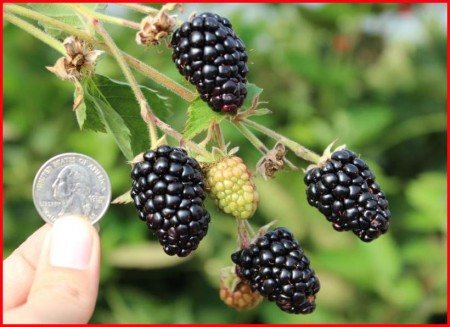

Traveller
Traveller - Prime-Ark Traveler - new, studless remontant blackberry.
- This variety is still little studied, but the Americans claim that productivity will be at its best.
- Berries weight 7 - 8 gr. The taste is sweet and sour.
- Bushes are erect, about two meters high, without thorns
- When grown for two harvests, the shoots are bent to the ground in autumn and covered with spunbond in 2 - 3 layers.
Bush blackberry varieties
Shrub blackberries have tough, poorly bending shoots. Their height rarely exceeds 2-2.5 m. In one bush there are usually 3-5 shoots. This is enough to get the harvest. Extra stems weaken the plant.
Creeping blackberry
Such blackberries have thin, easily bendable shoots. Their length reaches 5-6 m. The tops easily take root on their own. Over time, such a blackberry turns the site into impassable thickets. It is rarely found in country gardens.
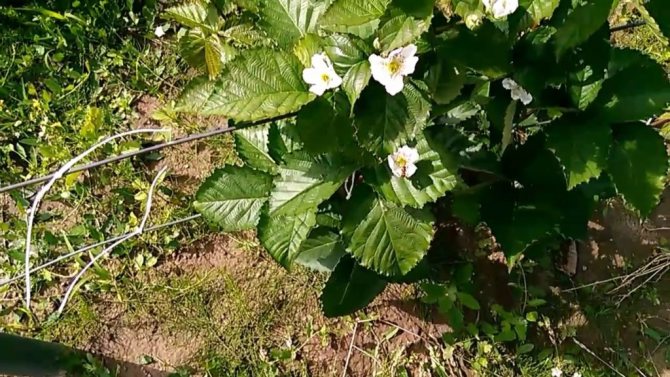

Mid-late varieties
Blackberries of July ripening are characterized by amicable ripening of fruits, their taste and aroma are more intense than that of early varieties.
Lawton
Lawton is an old variety of blackberries with upright shoots covered with large thick thorns. The root system gives a lot of growth, so the variety is easy to breed. Average frost resistance, in winters with frosts above 20 degrees, the bushes can freeze out. The berries are dark brown, medium in size, weigh up to 4 grams, have a sweet dessert taste, tender, but firm, therefore they are well transported, yield 10 kg. from the bush.
Chachanska Bestrna
Chachanska Bestrna (Сasanska Bestrna) - blackberries with black-purple berries, weighing up to 15 grams. The fruits are sweet, very fragrant, easily removable from the stalk and well transported. Bushes need a mandatory garter.
The previously described varieties also belong to the middle late: Black Satin, Loch Ness.
By areas of growth
Blackberry is a southerner. But due to the pleasant taste of berries and unpretentiousness, it has become widespread in different climatic zones.
For Moscow region
In the Moscow region, the remontant blackberry with erect shoots has become widespread. It is easy to care for them, but it is necessary to tie them to a support: the plant overloads itself with fruits. The best varieties for the region: Ruben, Black Magic, Prime Jim, Prime Arc, Prime Yan. They give two bountiful harvests with ease. With the complete removal of last year's shoots, the only crop increases.
For central Russia
For central Russia, early varieties of remontant blackberries are preferred. They will have time to give both crops before the onset of cold weather. In warm autumn, the plant pleases with berries until mid-October.
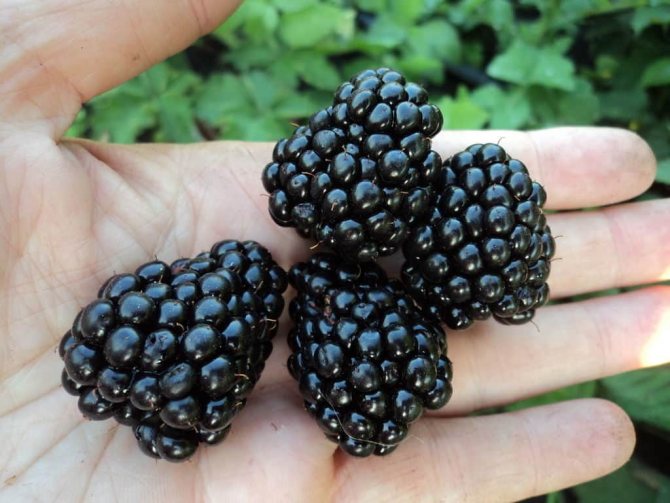

The varieties Freedom and Gigant have proven themselves excellently. Their shoots are erect, up to 2.5 m high. Plants are winter-hardy.
For the Urals
The climate of the Urals is continental. It is characterized by cold, long winters and hot but short summers. In such conditions, remontant blackberries feel unwell and bear fruit poorly.
But we can recommend some varieties that, with a good winter shelter, will delight with the harvest. It is worth paying attention to Ruben, Polar, Loch Tei.
Frost-resistant varieties of blackberries for the Moscow region and the middle zone
Blackberry variety Agavam


Agave
Agave - an old and very frost-resistant blackberry variety. It is even included in the State Register of varieties recommended for cultivation in the Russian Federation. It can be grown not only in the Moscow region, but also in Siberia.
- Productivity 3 - 6 kg.sometimes up to 10 kg. from one bush
- Berries weigh 3 - 5 grams, sweet taste, ripen in July - August.
- Fruiting lasts at least 15 years
- Shoots are erect, powerful, rigid with sharp thorns, 2.5 - 3 meters high
- Withstands frosts down to -40º, no shelter required for the winter
Advantages of the variety: beautiful flowering, stable fruiting, no need to cover for the winter, drought-resistant and shade-tolerant, grows on any soil and is generally very unpretentious.
Disadvantages: thorny shoots cause a lot of inconvenience, gives a lot of overgrowth.
In the south, Agaves can be grown both in the shade and in the sun. In the northern regions, berries in the shade may not have time to ripen, so planting in the sun is recommended. When planting, the root collar is deepened a few centimeters. The distance between the bushes is 1 meter, between the rows 1.8 - 2 meters. Although the shoots are strong, it is better to tie them up with a fan to the trellises.
Testimonials - very controversial. There are ardent supporters of this variety, but there are also ardent opponents who complain that Agavam shoots have filled the entire garden.
Blackberry Polar
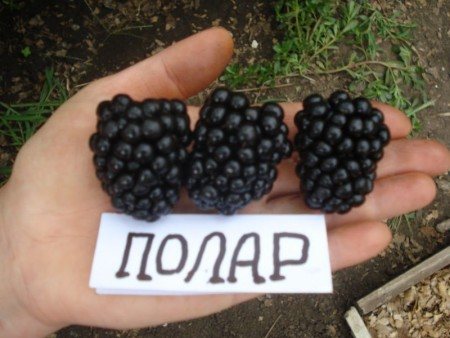

Polar
Polar - frost-resistant, thornless, early, large-fruited garden blackberry of Polish selection.
- Productivity 5 - 6 kg. berries from each bush (when wintering without shelter)
- The berries are very large, 10-12 g, sweet, in the southern regions they begin to sing in early July.
- Withstands frosts down to -30º shelter is not necessary. But most gardeners note that if the bushes are covered for the winter, then the yield increases several times. From this it follows that the fruit buds still freeze slightly and the shelter will not be superfluous at all.
- Stems are upright up to 2.5 m, strong, without thorns. They can break when bent to the ground. To facilitate the task, it is necessary to start tilting the shoots in advance, until they are lignified.
Advantages of the variety: frost resistance, large and tasty berries, thornless shoots, disease resistance, early ripening of the crop, good transportability.
Disadvantages: perhaps only one - it is difficult to bend the shoots to the ground for the winter.
Prefers to grow in the sun, on drained loamy soils. Dislikes damp, waterlogged places.
Reviews: only positive.
Unfortunately, the choice of frost-resistant blackberry varieties is not great. Only Agaves and Polar can hibernate without shelter, but it is better to cover Polar for the winter. All other varieties of this plant require mandatory shelter.
By external parameters
The repairing blackberry differs in the habit of the bush. But gardeners are interested in another difference: in the presence or absence of thorns.
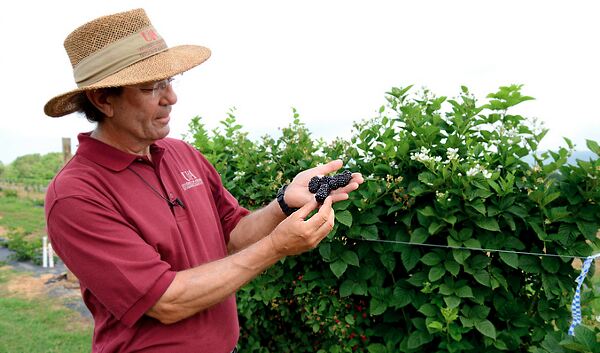

Prickly
Traditionally, the thorns of the plant are frequent and sharp. You have to pick berries with gloves. Which is inconvenient. And during trimming and garters, you have to wear special clothes so as not to damage the skin.
Shipless
Breeders have created thornless varieties of blackberries. It is much easier to care for such plants.
Diseases, pests: control and prevention
Disease is rather rare than a regular occurrence in remontant blackberries. All of its varieties are resistant to the main diseases characteristic of fruit and berry crops.
Below is a list of the most common diseases that can still affect a culture if not properly cared for:
| Disease | Symptoms | Treatment |
| Rust | Dusty yellow growths appear, which gradually increase in size. Shoots turn brown | The use of chemicals "Kuproksat", "Champion", copper sulfate |
| Powdery mildew | White powdery coating on the leaves. Unpleasant smell of berries | Spraying the bushes every 2-3 days with a solution of "Fitosporin" or "Trichodermina" |
| Anthracnose | Gray-purple spots at the edges of the leaves. On the shoots, purple spots with cracks. Peeling off the bark | Processing shoots with Bordeaux liquid. Application of fungicides "Fundazol", "Kuproksat", "Topaz" |
| Gray rot | Light brown spots on fruits, soft berries. Drying of leaves.Brown spots on shoots | The use of chemicals "Horus", "Strobi" |
| Septoriasis | Large light brown spots on leaves, shoots. Small black dots are sometimes visible. Berries become smaller and rot | Cutting and burning affected shoots. Spraying leaves and stems with Alirin B and Gamair solution |
Pests also rarely infect blackberry bushes. And the most effective protection is the complete removal of shoots, which is applied annually. Sometimes there are rare cases of damage to blackberry bushes by aphids. As a pest control, you should cut off the branches covered with aphids and spray the bush with Aktara or Aktellik.
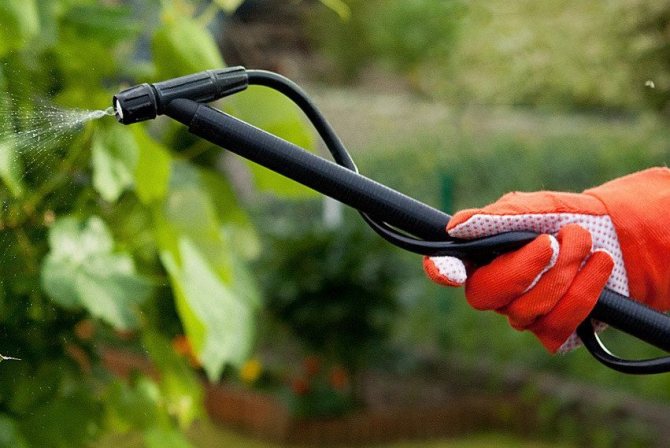

In order to prevent the emergence and spread of diseases and pests, preventive measures should be followed:
- plant bushes at a sufficient distance from each other;
- prevent stagnation of moisture in the soil;
- regularly stir up a layer of mulch;
- check stems and leaves for signs of damage;
- do not grow blackberries in one place for more than 15 years.
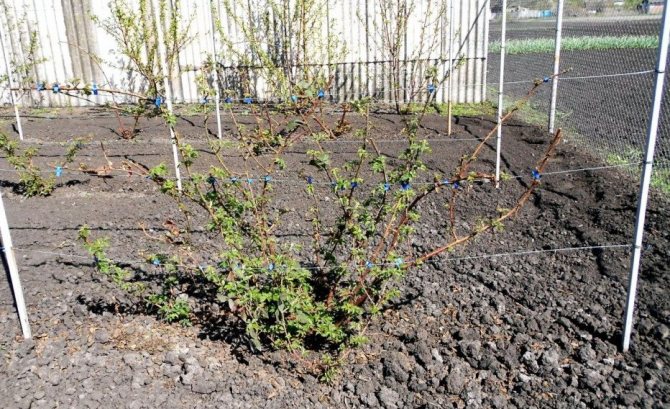

It will not be difficult even for a novice gardener to grow remontant blackberries on the site. With proper care and adherence to the rules of agricultural technology, it will regularly delight you with a good, tasty and, most importantly, healthy harvest.
By yield
Gardeners want to have the most productive variety of remontant blackberries at their dachas. But it is important to remember: the declared yield is obtained only if all fertilizing, watering, garters are observed.
Among the varieties with a high yield stand out:
- Ruben (up to 7 kg per square meter);
- Prime Arc (has large berries up to 10 g);
- Giant.


These varieties traditionally give two good harvests.
Features of cultivation.
Experts agree that in order to obtain a rich harvest, one must sacrifice one fruiting. In the conditions of the middle lane, it is not possible to collect a large harvest in autumn, the heat and sunshine are decreasing every day.
Because of this, the fruits become smaller. Two crops of full-fledged berries can be harvested only in warm regions.
Therefore, in most Russian regions, gardeners are trying to get one harvest of remontant blackberry fruits. The berries are larger and sweeter. To get two harvests, it is better to plant the bushes in an equipped greenhouse.
- You can plant repairing blackberries in separate bushes, leaving a free space around the bush for two meters. If you plant a shrub in rows, then the bushes are planted no closer than half a meter from each other, leaving a distance between the rows of at least two meters.
- Blackberries love sunny areas, but without drafts and scorching sun, it is better to find a little shading. For planting, you definitely need acidic soil. At low acidity, it is artificially acidified.
- Repaired blackberries most often have strong and reliable branches that can grow without assistance. But with very abundant harvests of berries, it is better to place them on a trellis so that they do not break under the load of fruits.
- Excess branches must be cut off in time, this will improve the ripening of the crop.
- Top dressing of bushes is carried out in the spring, introducing organic matter into the soil. And, in order to improve the ovary of fruits, potassium preparations are introduced.


How the remontant blackberry reproduces
Repaired blackberries do not produce root shoots like traditional ones. But there are methods for its reproduction.
Layers
Reproduction by layering is the easiest way. The top of the shoot is slightly incised, pinned to the ground and sprinkled with soil. The place is regularly moistened. After 3-4 weeks, a new bush is ready for planting in a permanent place.


Cuttings
For this method of reproduction, a part of the stem with 3-4 buds is cut off. The upper cut is made straight and waxed. Lower - cut at an angle of 45 degrees. Leave 2-3 leaves, the rest are removed. The lower cut is placed in a root former solution. A glass with a handle is placed away from direct sunlight. After 3 weeks, the shoot takes root.
Seeds
Gardeners practically do not use this method because of its laboriousness. In addition, only varieties can be propagated in this way, hybrids do not transmit parental qualities.
See also
When and how to properly prune blackberries to have a good harvestRead
Seeds are scattered over the surface of the moistened soil and placed in a greenhouse. The container must be constantly ventilated, the soil must be moistened. After the appearance of real leaves, the blackberry is planted in the mother cell, and the next year - in a permanent place in the garden.


Root buds
The perfect way to rejuvenate your culture. The old plant is dug up, the rhizome is examined. Allocate healthy areas with 2-3 kidneys. The root is cut into pieces, the slices are sprinkled with activated charcoal. Then the pieces of the root are planted in pre-prepared planting pits. It is important to regularly moisten the soil before the stems appear.
Reproduction
The issue of reproduction of remontant blackberries worries many gardeners. This is due to the fact that many varieties of seedlings are not cheap, and many want to expand their plantings. In this case, you can propagate the bushes on your own, especially the blackberry is one of the easiest crops to propagate. Its offspring have a high survival rate.
Layers
It is believed that the method of propagation by layering saves a maximum of time and effort for the gardener. The whole process consists in the fact that the shoot from the main bush is bent to the ground and fixed with a hairpin. Then the place of the fold is covered with fertile soil and watered regularly. After a while, this area will take root and soon it will be possible to separate a new bush.


There is another method of reproduction by layering, in which a small trench is dug and the shoot is completely laid in it. It is also covered with earth and watered regularly. With this method, the shoot forms several bushes. However, judging by the reviews, the bushes obtained in this way are usually weaker and less productive than from the apical cut.
Cuttings
This method is much more time-consuming, but this is how you can breed blackberries in large quantities.
The whole process includes the following stages:
- An adult bush must be carefully dug out so as not to damage the roots.
- From the root processes, choose the strongest ones, which reach at least 0.5 m in length.
- Cut them into pieces of 10-15 cm each.
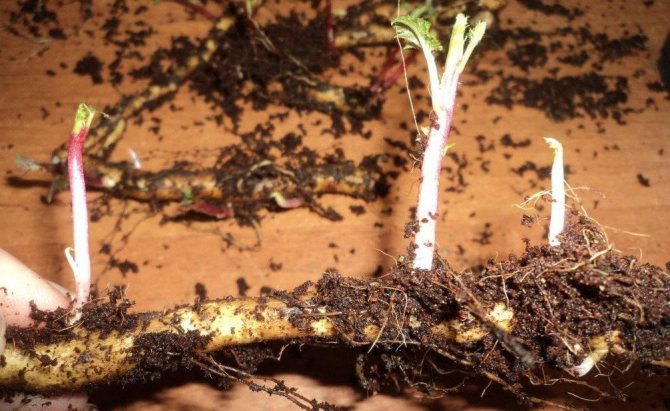

This is how cuttings are obtained. When the time comes for planting in the soil, they are soaked in a special growth stimulant, which can be easily purchased at any specialized store. Cuttings are laid flat in trenches or holes and covered with earth. This is followed by standard care, which consists of watering and feeding.
Seeds
When it comes to other fruit and berry crops, seed propagation is always a lottery. It is impossible to know for sure whether something will grow from the seed and whether the plant will retain its varietal characteristics. The situation is different with remontant blackberries. Its seeds almost always germinate. But despite this, gardeners rarely resort to this method.
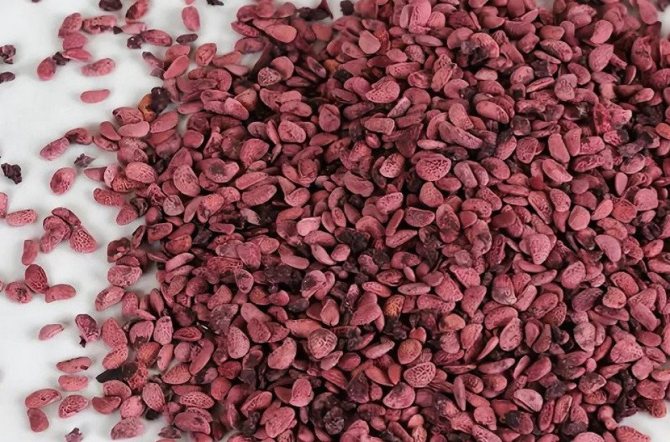

Due to the fact that the seeds are notable for poor germination, experienced gardeners recommend resorting to such a trick as scarification. This is damage to the seed coat. This can be done manually or using special devices that are sold in stores.
Learn how to grow blackberries from seeds at home.
The process of planting seeds itself looks like this:
- Small boxes are filled with peat chips, coarse river sand, or a mixture of them, in approximately equal proportions.
- The mixture must be moistened and the seeds placed in it. The depth should not be more than 7 cm.
- After the seedling forms a second leaf, it can be transplanted either into an individual container or into open ground.
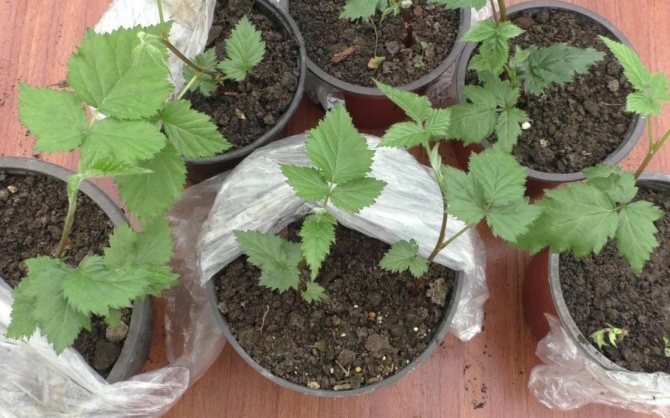

With this cultivation, the first crop can be harvested in at least 3 years.
Root buds
This method is best suited for propagation of mature and old bushes.
This process is carried out in this way:
- The bush must be completely dug out of the ground.
- With a sharp knife, the bush must be divided into several parts so that each has its own growth point.
- The sections should be sprinkled with wood ash, activated carbon or chalk.


Thus, you will get several independent bushes, ready for planting.
Features of planting and care
To obtain regular harvests, it is recommended to follow the rules of planting and caring for blackberries.
Soil requirements
Blackberries prefer slightly acidified, medium-nutritious soil. It grows well on medium loam and sandy loam. Heavy loams should be sanding. It is recommended to acidify sandy soils with peat.
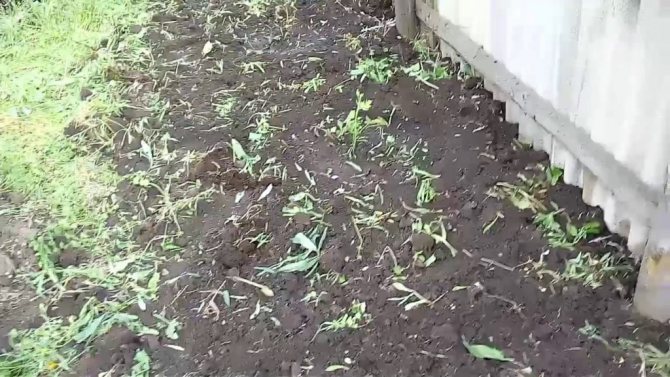

Blackberries love organic matter. Before planting, mature compost or humus should be added to the soil. It is important to avoid high groundwater levels in bush locations.
Dates and schemes of disembarkation
Repaired blackberries are planted twice a year: in spring (in April-May) and in autumn (in September-October). Spring planting has an advantage: the seedling will have time to build up the root system and successfully overwinter.
When planting in autumn, the gardener risks getting a frozen bush in the spring. At later planting dates, the plant should be carefully covered, the soil should be moistened.
The shrub loves sunlight. This should be taken into account when placing bushes. Plants with a powerful habit are placed at a distance of 70-90 cm from each other. Compact plants can be planted in 40-50 cm.
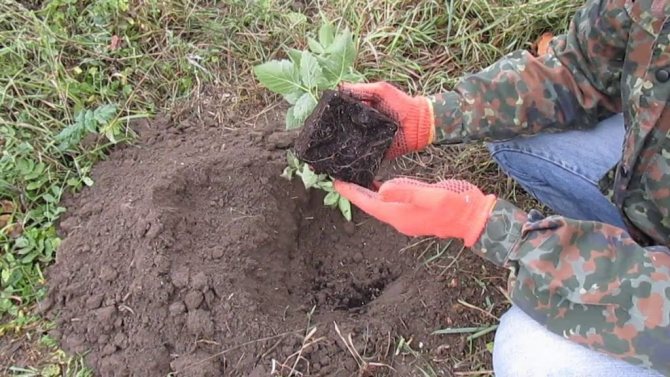

Optimal climatic conditions
The plant is a native of the southern regions. Therefore, it grows and bears best in regions with mild winters and long, warm summers. Moreover, the plant is sensitive to the number of sunny days. But breeders create frost-resistant varieties and hybrids with a short ripening period. Subject to the rules of care and the correct selection of the type, you can get two bountiful harvests in problem regions.
Top dressing
Blackberries are responsive to organic inputs. When planting, it is recommended to fill the planting hole with compost or humus. During the season, it is recommended to add compost mixed with mulch under the bushes 2-3 times. In the fall, under each plant, it is required to apply phosphorus-potassium fertilizers in the amount of 20 g. After application, it is recommended to loosen the soil and cover with mulch.
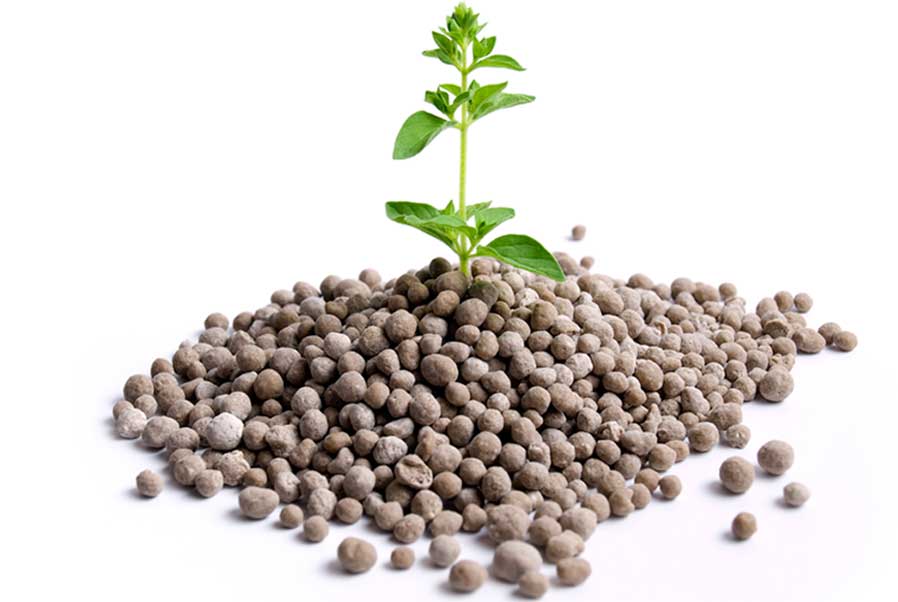

After the snow melts, it is required to feed the bushes with nitrogen fertilizers (urea). 10-12 g should be added under each plant. Then it is recommended to remove the old mulch and cover the near-stem space with a new one. The layer should be 15-20 cm thick.
Pruning
After the plant leaves wintering, it is recommended to carry out sanitary pruning. All frozen, broken shoots are subject to removal. Then 2-3 pinches are carried out in the summer: lateral fruiting shoots are shortened at the height of the main one 30 cm and 70 cm. In the fall, all shoots (old and new) are shortened to a size that the grower can cover.... If you plan to get one crop, old shoots are cut at ground level.
Diseases and pests: ways to deal with them
Due to the peculiarities of cultivation, remontant blackberries are practically not affected by the raspberry beetle and the raspberry fly. But in a dry summer, the plant is threatened by a spider mite. To prevent damage to plantings, it is recommended to monitor soil moisture.
Landings are sometimes affected by anthracnose. To prevent the disease, it is recommended to make top dressing in a timely manner.
Growing technology
Although most blackberry varieties are unpretentious to growing conditions, a good harvest cannot be achieved without proper care. Using the instructions below, even a novice gardener can handle the cultivation of remontant blackberries.
Did you know? On an industrial scale, blackberries are rarely grown. Most often it is used as a horticultural crop. The exception is Mexico. This country
—
world leader in the cultivation of this crop.
Timing
There is still debate about when it is better to plant a blackberry.There is still no definite opinion, so the gardener can choose a convenient time for himself:
- In the spring... When planting in the spring, it will be possible to harvest the first harvest this year, since remontant fruit crops have the ability to bear fruit on annual shoots. With this planting, it is important to plant the seedlings before the buds grow on them. This means that you need to carry out the procedure as early as possible.
- In autumn... If the seedlings are planted in the fall, then they will have time to gain strength before the next fruiting period. The advantage of the remontant blackberry is that it is not afraid of the cold and the risk that the young plant will die in winter is very small. The optimal month for planting is October. It is during this period that the most favorable conditions for growth are formed.
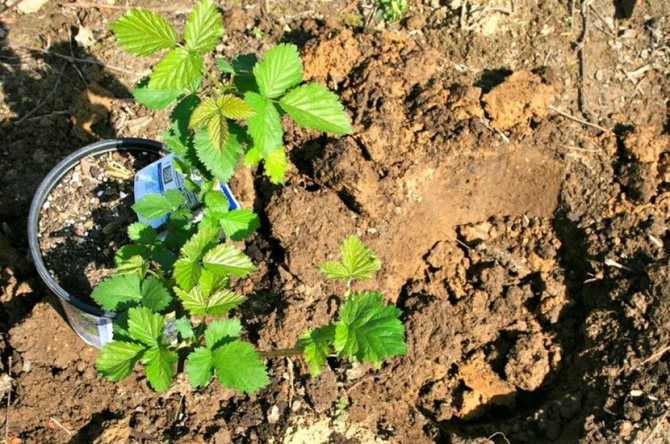

Site selection, soil requirements
The entire growing process begins with the selection of a site for planting. This stage must be approached responsibly. Improper growing conditions can lead to diseases or even a complete lack of crops.
An ideal site for blackberries would be a place with the following parameters:
- Penumbra... Blackberry, like other fruit and berry crops, loves an abundance of sunlight, but does not tolerate open sunlight. Many remontant varieties also tolerate shading well, which allows planting to be placed in light partial shade.
- Wind protection... The north and west winds are the most dangerous for plants. Care must be taken to protect the planting area from them. To do this, you can build artificial protective structures or plant nearby plants that will block access to the wind.
- Humidity... The blackberry root system does not like excess moisture, so you need to make sure that the groundwater level does not exceed 1 m from the soil surface.
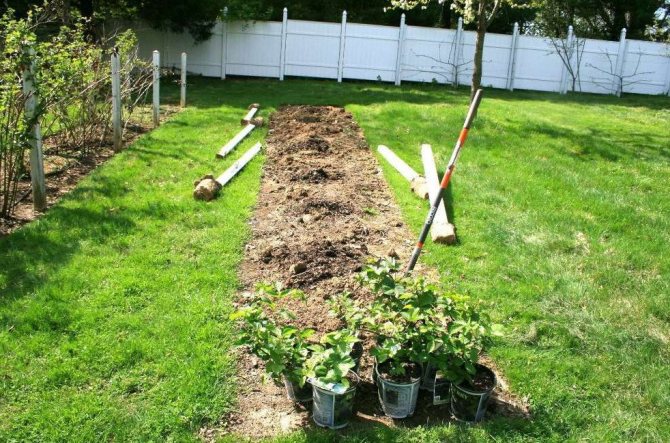

Repaired blackberry grows on almost any soil. Worst of all, heavy and sandy soils are suitable for it, and best of all - light loam or moderately fertile sandy loam. The optimum acidity level is between 6 and 7 pH.
Important! If the acidity of the soil in your area exceeds the optimal level, then a year before planting the blackberry, you can neutralize it with chalk or dolomite flour.
A good place will also be a site where crops such as used to grow:
- legumes and cereals;
- field crops;
- siderates;
- vegetables.
Preparation of trellis, site and planting pit
It is recommended to prepare the site a year before the intended planting of seedlings.
The whole process can be divided into the following stages:
- First, weeds and excess vegetation are cleaned. Any debris, foliage and building materials are removed.
- If pests are present in the soil or plants that have been affected by the disease grew in this place, then the site must be treated with special preparations. To prevent pests, you can pour boiling water over the entire soil. It kills larvae and eggs, from which insect pests then emerge.
- After that, you need to dig up the site.
- The next important step is fertilization. The dug soil is mixed with organic (10 kg / 1 m²) and mineral fertilizers (superphosphate 10-16 g / 1 m²).


The tapestries should be prepared in advance. They support the plant during fruiting, preventing the branches from breaking under the weight of the fruit, and also preventing the wind from bending or damaging the plants. There are quite a few types of tapestries, ready-made copies can be purchased in the store, but anyone can handle their own production if they wish. All that is needed for this is the construction of three-meter pillars from any convenient material (iron, wood, plastic) and wire.
You will be interested to know how to make trellises (props) for blackberries.
- Two holes 0.5 m deep are dug at both ends of the blackberry plantings. The bottom is covered with construction waste.
- Pillars are installed in the pits, covered with earth.When the pits are filled up, the surface near the pillars must be carefully stamped down.
- The blackberry trellis requires fastening and strong wire tension every 50 cm.
This completes the installation.
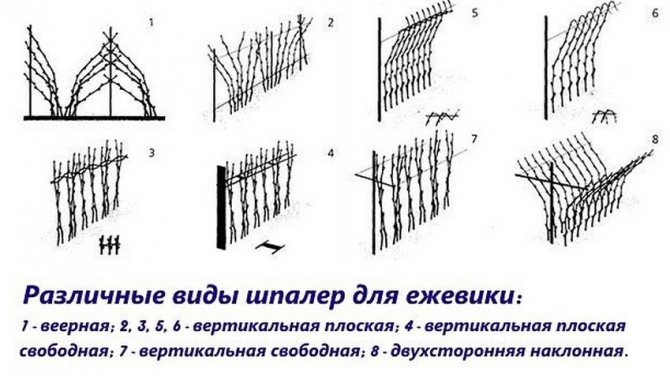

Requirements for seedlings
Even with good care, the plant may not live up to the grower's expectations due to a wrongly purchased seedling.
Important! Experienced gardeners know about this trick - if you want to check if the seedling is alive, then scratch a small area of the seedling bark with your fingernail and, if there is a new green surface under the stiff part, then the plant is alive and healthy.
In order not to be disappointed with your plantings in the future, it is important to observe the following rules when buying a seedling:
- Purchase seedlings only from proven nurseries. Only there you will be guaranteed health and compliance with the plant variety.
- Pay attention to the condition of the seedling - it should not show signs of frostbite, damage or damage by insects and diseases.
- The root system of the seedling should have several strong root shoots.
- If the plant already has green basal buds, then this is a sure sign of health, it is best to take just such specimens.
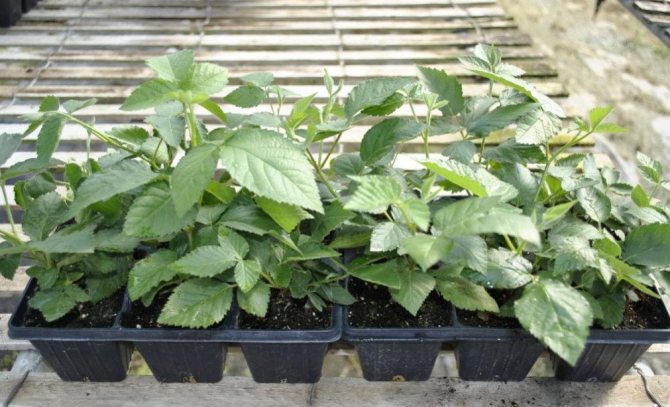

Technology and seating schemes
The very process of planting remontant blackberry seedlings is not very different from planting any other fruit crop. It is recommended to do this either by tape or bush method.
They are similar to each other, their only difference is that in the first case, a furrow is dug, and in the second, separate pits:
- In any of these two ways, the distance between the bushes should be at least 1 m, and between the rows - up to 2.5 m.
- The depth of the pits should be about 30 cm.
- The seedling is placed on the bottom and the roots are straightened. Top covered with earth.
- The earth near the bush needs to be compacted and 6 liters of water poured into it.


Watering immediately after planting must be done, regardless of the weather. If there was no precipitation for several days, then watering is repeated.
Blackberry Care (Highlights)
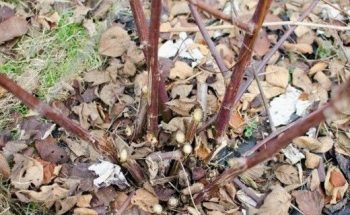

Leave only 6 or 7 stems during fall pruning
Blackberries are easy to care for. But still, she needs some measures:
- Watering. More frequent watering (twice a week) is needed only for a first-year seedling, from the second year of life it should be watered only when necessary (during a dry period), and also when the fruits are tied.
- Loosening. You need to do this procedure regularly, preferably after watering, at the same time removing weeds. To facilitate the work, you can use mulch - and the looseness of the soil will be preserved, and will protect from weeds.
- Top dressing. Blackberries may well be satisfied with covering mulch before winter. But if we are talking about increasing yields, then organic fertilizing with compost or humus is needed at the rate of 5 kg per square of soil, and during the ripening of the crop - fertilizing with potash fertilizers.
Garden blackberry: description
For growing in the garden, all cultivated varieties that have been described above are suitable. There is also a hybrid variety called Marion, which deserves special consideration. This plant, as a raspberry-blackberry crop, has become the standard for breeders when breeding new products. Bushes of this variety with branches covered with thorns reach six meters in height. Fruits weighing 5 grams have an amazing taste and aroma. The first berries ripen in the last weeks of June. Yields are always consistently high.


